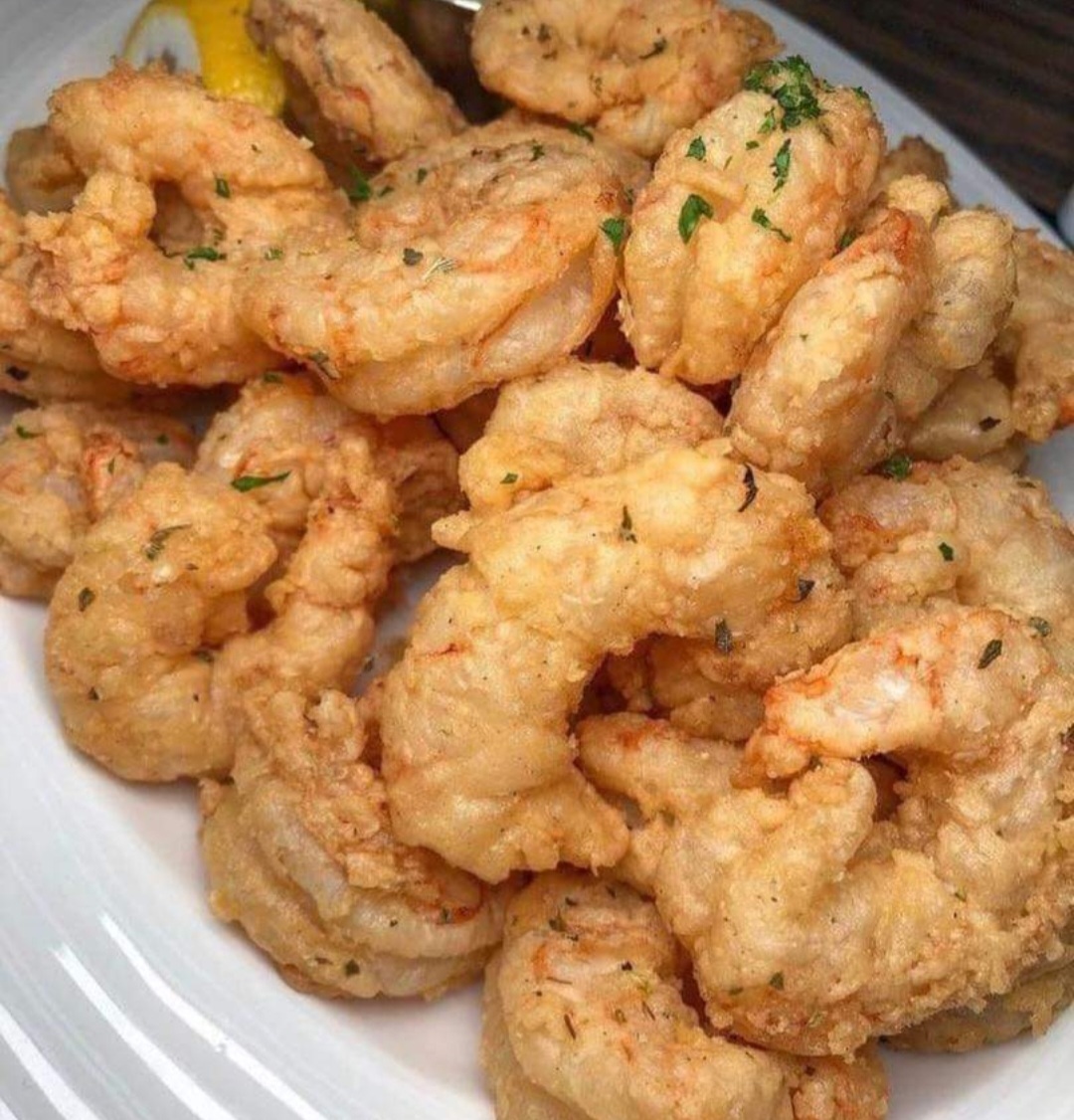I don’t know about you, but I’m obsessed with shrimp and a good majority of people would agree with me.
Shrimp is an extremely popular food around the world, and apparently, it has been for thousands of years.
These shrimp are super crispy and I don’t know about you but I prefer shrimp fried with just flour.
Ingredients
Canola oil
2 large eggs, beaten
1 cup whole milk
2 tablespoons Chile hot sauce (such as Cholula)
2 pounds large peeled, deveined raw shrimp
3/4 cup (about 3 1/4 oz.) all-purpose flour
2/3 cup (about 2 7/8 oz.) cornmeal
1 1/2 teaspoons kosher salt
1 teaspoon black pepper
1/2 teaspoon cayenne pepper
For serving: lemon wedges, cocktail sauce, rémoulade (optional)
How To Make Fried Shrimps
Step 1 Pour oil to a depth of 2 inches in a large deep skillet; heat over medium-high to 370°F.
While oil heats, whisk together eggs, milk, and hot sauce in a shallow dish; add shrimp to the mixture, and toss to coat.
Whisk together flour, cornmeal, salt, black pepper, and cayenne pepper in a separate shallow dish.
Step 2 Remove 6 to 8 shrimp from egg mixture, shaking excess off; dredge in flour mixture.
Place dredged shrimp in hot oil; fry until coating is golden and crisp, about 2 minutes.
Remove with a slotted spoon to a baking sheet lined with paper towels.
Repeat with remaining shrimp, bringing oil back to 370°F over medium-high heat before adding each batch of shrimp.
Step 3 Serve fried shrimp with lemon wedges, cocktail sauce, and rémoulade if desired.
Fried shrimp can be a versatile and delicious dish with many variations. Here are some ideas to help you switch things up and tips to perfect your fried shrimp:
Variations of Fried Shrimp
Classic Breaded Fried Shrimp:
Breading: Coat the shrimp in seasoned flour, then dip in beaten eggs, and finally dredge in breadcrumbs (or panko for a crunchier texture).
Seasoning: Add garlic powder, paprika, or lemon zest to the breading for extra flavor.
Tempura Shrimp:
Batter: Use a light tempura batter made from a mix of flour, cornstarch, and cold water (sometimes with sparkling water for added lightness).
Cooking Tip: Ensure the oil is hot (around 350°F) to make the batter crispy without becoming greasy.
Coconut Shrimp:
Coating: Combine shredded coconut with panko breadcrumbs for the coating.
Serving: Serve with a sweet chili or mango dipping sauce to complement the coconut flavor.
Southern Fried Shrimp:
Breading: Use cornmeal and flour seasoned with Cajun spices or Old Bay seasoning for a Southern twist.
Serving: Serve with tartar sauce or remoulade.
Popcorn Shrimp:
Size: Use smaller shrimp, coated in seasoned flour or panko, and fry them until golden.
Serving: Great as a snack or appetizer with cocktail sauce or garlic aioli.
Beer-Battered Shrimp:
Batter: Use a beer batter for a light, crispy crust. Mix beer (preferably lager) with flour, a pinch of baking powder, and seasonings.
Tip: Let the batter rest for 10-15 minutes before using.
Spicy Fried Shrimp:
Seasoning: Add cayenne pepper, chili powder, or sriracha to the batter or breading for a kick.
Dipping Sauce: Serve with a spicy mayo or buffalo-style dipping sauce.
Tips for Perfect Fried Shrimp
Use Fresh or Defrosted Shrimp: Fresh shrimp gives the best flavor, but if using frozen, defrost completely and pat dry to avoid excess moisture which can affect the crispiness.
Seasoning: Season every layer – the shrimp itself, the flour, and the breadcrumbs or batter. This ensures that each bite is flavorful.
Oil Temperature: Keep the oil at 350°F (180°C) to ensure the shrimp fry quickly without becoming greasy. Use a thermometer if necessary to monitor the oil.
Don’t Overcrowd the Pan: Fry shrimp in small batches. Overcrowding reduces the oil temperature, resulting in soggy shrimp.
Rest on a Wire Rack: After frying, place the shrimp on a wire rack rather than paper towels. This prevents them from getting soggy.
Sauces and Dips: A variety of sauces can enhance your fried shrimp. Try classic tartar sauce, cocktail sauce, garlic butter, or a spicy dipping sauce.
With these variations and tips, you can create perfectly crispy and flavorful fried shrimp every time!
The nutritional information for fried shrimp can vary depending on the preparation method, the size of the shrimp, and the type of breading or batter used.
Below is a general breakdown for one serving of fried shrimp (about 4-5 medium shrimp):
General Nutritional Information for Fried Shrimp (Per 4-5 medium shrimp, deep-fried)
Calories: 200-300 kcal
Protein: 18-20 g
Carbohydrates: 15-20 g
Fat: 10-15 g
Saturated Fat: 1-2 g
Cholesterol: 120-150 mg
Sodium: 300-400 mg
Fiber: 0-1 g (depends on breading type)
Sugars: 0-2 g (depends on the batter or dipping sauce)
Key Factors Affecting Nutritional Values:
Breading or Batter:
Panko or breadcrumb coatings generally add more carbohydrates and calories.
Tempura batter tends to be lighter but still adds carbs and fat.
Coconut shrimp or other variations with sugary or high-fat ingredients will increase both calories and fat content.
Oil Absorption:
The type and amount of oil used for frying will impact the fat content. Healthier oils like canola, peanut, or sunflower oil are better options.
Draining shrimp on paper towels or using a wire rack can reduce excess oil and fat.
Portion Size:
Larger portions or jumbo shrimp will increase all macronutrients, including calories and fat.
Sauces:
Dipping sauces like cocktail sauce, tartar sauce, or aioli can add extra calories, sugar, and fat. Opt for lighter or homemade versions to control these factors.
Shrimp:
Shrimp itself is naturally low in calories and high in protein, so the frying process and added ingredients (breadings, oils, sauces) contribute the majority of the calories, fat, and carbs.
For a lighter version, you can bake or air-fry the shrimp, which will significantly reduce the fat content while keeping the shrimp crispy.
